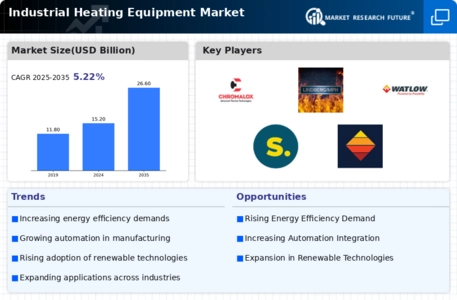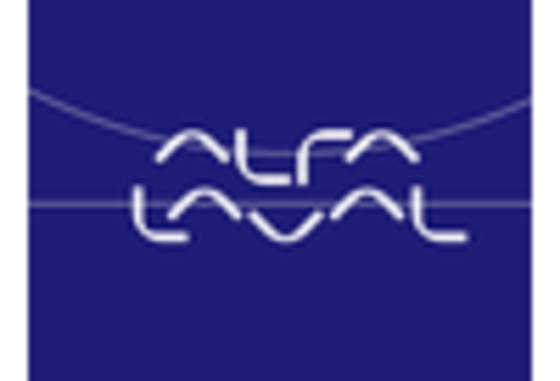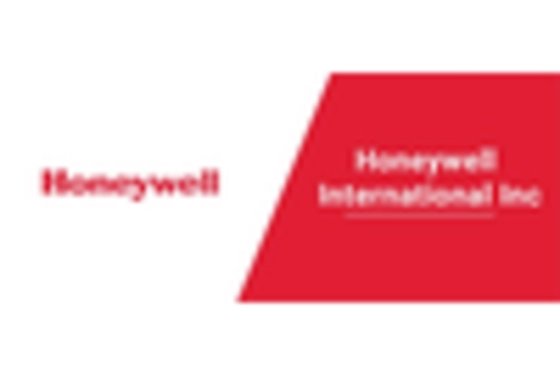Growth in Renewable Energy Sources
The growth in renewable energy sources is emerging as a pivotal driver for the Industrial Heating Equipment Market. As industries seek to transition towards more sustainable energy solutions, the integration of renewable energy into heating processes is gaining traction. Technologies that utilize solar, biomass, and geothermal energy for heating applications are becoming increasingly popular. This shift not only aligns with global sustainability goals but also offers potential cost savings in the long run. For instance, systems that harness solar energy for industrial heating can significantly reduce reliance on fossil fuels. As the adoption of renewable energy sources continues to rise, the demand for compatible industrial heating equipment is expected to grow, thereby influencing the trajectory of the Industrial Heating Equipment Market.
Rising Demand for Energy Efficiency
The Industrial Heating Equipment Market is experiencing a notable shift towards energy-efficient solutions. As industries strive to reduce operational costs and comply with stringent environmental regulations, the demand for advanced heating technologies is increasing. Energy-efficient heating systems not only lower energy consumption but also minimize greenhouse gas emissions. According to recent data, energy-efficient industrial heating equipment can reduce energy usage by up to 30%, which is a compelling incentive for manufacturers. This trend is likely to drive innovation in the sector, as companies seek to develop and implement more sustainable heating solutions. Furthermore, the growing emphasis on sustainability is expected to bolster the market for energy-efficient heating equipment, making it a critical driver in the Industrial Heating Equipment Market.
Expansion of Manufacturing Activities
The expansion of manufacturing activities across various sectors is a key driver for the Industrial Heating Equipment Market. As economies recover and grow, there is an increasing need for efficient heating solutions in manufacturing processes. Industries such as automotive, food processing, and pharmaceuticals are expanding their production capacities, which in turn drives the demand for industrial heating equipment. For example, the automotive sector is increasingly utilizing advanced heating technologies for processes like curing and drying, which are essential for production efficiency. This trend is expected to continue, with the manufacturing sector projected to grow at a steady rate, thereby creating a robust demand for industrial heating solutions. Consequently, the expansion of manufacturing activities is likely to be a significant contributor to the growth of the Industrial Heating Equipment Market.
Regulatory Compliance and Safety Standards
Regulatory compliance and safety standards are becoming increasingly stringent, influencing the Industrial Heating Equipment Market. Governments and regulatory bodies are implementing stricter guidelines to ensure safety and environmental protection in industrial operations. This has led to a heightened demand for heating equipment that meets these regulations. Manufacturers are compelled to invest in advanced heating technologies that not only comply with safety standards but also enhance operational efficiency. For instance, equipment that minimizes emissions and adheres to energy efficiency standards is becoming a prerequisite for many industries. As compliance becomes a critical factor in procurement decisions, the demand for reliable and compliant industrial heating equipment is expected to rise, thereby driving growth in the Industrial Heating Equipment Market.
Technological Advancements in Heating Solutions
Technological advancements are significantly shaping the Industrial Heating Equipment Market. Innovations such as induction heating, infrared heating, and advanced control systems are enhancing the efficiency and effectiveness of heating processes. These technologies not only improve performance but also offer greater precision and control over heating applications. For instance, induction heating systems can achieve rapid heating times and reduce energy waste, making them increasingly popular in various industrial applications. The integration of smart technologies, such as IoT and AI, is also transforming the landscape, allowing for real-time monitoring and optimization of heating processes. As industries continue to adopt these cutting-edge technologies, the demand for advanced heating equipment is expected to rise, further propelling the growth of the Industrial Heating Equipment Market.


















Leave a Comment